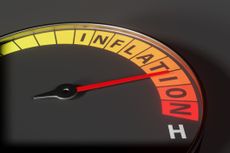Unpopular Funds Yield Surprising Returns
Here’s how to profit by buying after other investors have fled a market sector.

Buying what’s popular is usually a bad idea. Instead, look closely at the unloved parts of the market for clues about where to best invest your money.
As is so often the case, Warren Buffett put it best. “The future is never clear; you pay a very high price in the stock market for a cheery consensus,” he said.
Look at the record. From 1997 through 2000, individual investors poured about $775 billion into domestic stock funds. In contrast, investors yanked some $400 billion from domestic stock funds from 2008 through 2011, including $93 billion last year alone. So perhaps U.S. stocks will continue to rally from here (as of February 9, Standard & Poor’s 500-stock index had climbed 24% since bottoming last October 3).

Sign up for Kiplinger’s Free E-Newsletters
Profit and prosper with the best of expert advice on investing, taxes, retirement, personal finance and more - straight to your e-mail.
Profit and prosper with the best of expert advice - straight to your e-mail.
Morningstar takes a more specific approach to flows in and out of funds. Since 1993, the investment research firm has tracked the subsequent three-year performance of the three least loved and the three most loved fund categories.
The results are striking. The unloved funds returned an annualized 8.9%, while the loved funds returned just 6.5%. Over the same period, the S&P 500 returned 8.4% annualized, and the MSCI EAFE index, which tracks stocks of mainly large companies in developed foreign markets, gained 5.2% a year.
Here’s a look at how this pattern has worked in the not-too-distant past. In 2006, investors dumped health care, mid-cap growth and technology funds more than any other fund categories. That same year, they piled into foreign large-company blend funds, foreign large-company value funds and world stock funds, which invest in both U.S. and foreign stocks.
From 2007 through 2009, the three unloved sectors lost an annualized 0.5%. That wasn’t great, but the most popular categories plunged an annualized 5.7% in a period that included the worst bear market since the Great Depression. The S&P 500 lost an annualized 5.6%, and the EAFE index dropped an annualized 6%.
Like any strategy, buying the unloved doesn’t work all the time. When the market is on a multiyear roll, buying the loved categories works better. In 1997, as a financial crisis got under way in Asia, the three categories investors exited most feverishly were Asia funds that don’t invest in Japan, Asia funds that do include Japan, and utility funds. Investors piled into three domestic groups: large-company blend, large-company value and small-company value funds.
Three years later, the three unloved categories had returned an annualized 8%. That’s not too shabby. But the loved categories had gained 8.8%. The S&P rose an annualized 12.3%, and the EAFE index climbed an annualized 9.4%.
Russ Kinnel, director of fund research at Morningstar, says the strategy of investing in the least popular sectors works best in the “pivot years.” By that, he means stretches like the 2000-02 bear market, during which tech stocks, after being on fire for years, suddenly collapsed and investors rediscovered small-company stocks and value stocks.
In 1999, investors bailed out of all value funds -- regardless of the size of the companies they focused on. Where did they put their money? Into large-company growth, large-company blend and technology sector funds.
Over the subsequent three years, those unloved value funds returned an annualized 1.5%, while the rest of the market melted down. The S&P 500 tanked an annualized 14.6%, the EAFE index tumbled 17.2%, and the previously loved categories plunged an annualized 22.7%.
It makes little sense to use this strategy in isolation. “Don’t go out and gut your portfolio because of it,” cautions Kinnel. Instead, it’s a “reality check. It points you toward what’s cheap and away from what’s expensive. It’s a sound contrarian strategy.”
Indeed, from a valuation perspective, selling tech in the late 1990s and buying value stocks made perfect sense. Price-earnings ratios for tech stocks were insanely high, and many tech stocks were bid up even though they had no earnings. At the same time, value stocks were much better values than usual; many were dirt-cheap.
What’s most loved and unloved today? In 2011, investors sold $40 billion of large growth funds, $23 billion of large blend funds and $16 billion of global stock funds (which mainly invest in stocks of developed nations). Meanwhile, investors bought $20 billion in emerging-markets stock funds, $9 billion in commodities funds and $4 billion in foreign large-company growth funds.
Steve Goldberg (bio) is an investment adviser in the Washington, D.C., area.
Get Kiplinger Today newsletter — free
Profit and prosper with the best of Kiplinger's advice on investing, taxes, retirement, personal finance and much more. Delivered daily. Enter your email in the box and click Sign Me Up.

-
 Why Does the Fed Prefer PCE Over CPI?
Why Does the Fed Prefer PCE Over CPI?Inflation has been top of mind for lots of folks in recent years. Most of Wall Street follows the CPI but the Fed favors the PCE. Here's why.
By Charles Lewis Sizemore, CFA Published
-
 Five Great Places to Live in Wyoming
Five Great Places to Live in WyomingWhether you prefer the buzzy affluence of Jackson Hole, rodeo towns or mountain towns, Wyoming should be on any nature lover’s list.
By Drew Limsky Published
-
 ESG Gives Russia the Cold Shoulder, Too
ESG Gives Russia the Cold Shoulder, TooESG MSCI jumped on the Russia dogpile this week, reducing the country's ESG government rating to the lowest possible level.
By Ellen Kennedy Published
-
 Morningstar Fund Ratings Adopt a Stricter Curve
Morningstar Fund Ratings Adopt a Stricter Curveinvesting Morningstar is in the middle of revamping its fund analysts' methodology. Can they beat the indices?
By Steven Goldberg Published
-
 Market Timing: The Importance of Doing Nothing
Market Timing: The Importance of Doing NothingInvestor Psychology Investors, as a whole, actually earn less than the funds that they invest in. Here’s how to avoid that fate.
By Steven Goldberg Published
-
 Commission-Free Trades: A Bad Deal for Investors
Commission-Free Trades: A Bad Deal for Investorsinvesting Four of the biggest online brokers just cut their commissions to $0 per transaction. Be careful, or you could be a big loser.
By Steven Goldberg Published
-
 Vanguard Dividend Growth Reopens. Enter at Will.
Vanguard Dividend Growth Reopens. Enter at Will.investing Why you should consider investing in this terrific fund now.
By Steven Goldberg Published
-
 Health Care Stocks: Buy Them While They're Down
Health Care Stocks: Buy Them While They're Downinvesting Why this sector should outperform for years to come
By Steven Goldberg Published
-
 Buy Marijuana Stocks Now? You'd Have to Be Stoned.
Buy Marijuana Stocks Now? You'd Have to Be Stoned.stocks Don't let your investment dollars go to pot
By Steven Goldberg Published
-
 4 Valuable Lessons From the 10-Year Bull Market
4 Valuable Lessons From the 10-Year Bull MarketInvestor Psychology Anything can happen next, so you must be mentally prepared.
By Steven Goldberg Published